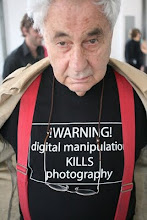 by iconeye ... & lees verder ...
by iconeye ... & lees verder ... “I go out to find photographs [...] in which the artificial and the natural take each other’s forms and in which one is unable to see if things are being constructed or destroyed. I think that is the most interesting thing that can be said right now about the cities in which we live, and the landscapes in which we dwell (and vice versa).” Bas Princen explained in a conversation with Mark Pimplott...
“I go out to find photographs [...] in which the artificial and the natural take each other’s forms and in which one is unable to see if things are being constructed or destroyed. I think that is the most interesting thing that can be said right now about the cities in which we live, and the landscapes in which we dwell (and vice versa).” Bas Princen explained in a conversation with Mark Pimplott... Like islands, the buildings in photographer Bas Princen’s latest series are isolated objects in the landscape. Travelling to five Middle Eastern cities – Cairo, Istanbul, Dubai, Beirut and Amman – Princen was looking for urban refuges. Amid the sprawl he found extraordinary suburbs and gated communities but also monumental buildings. The ones we have selected over the following pages have an almost biblical quality to them – unquestionably modern and yet strangely ancient.
Like islands, the buildings in photographer Bas Princen’s latest series are isolated objects in the landscape. Travelling to five Middle Eastern cities – Cairo, Istanbul, Dubai, Beirut and Amman – Princen was looking for urban refuges. Amid the sprawl he found extraordinary suburbs and gated communities but also monumental buildings. The ones we have selected over the following pages have an almost biblical quality to them – unquestionably modern and yet strangely ancient.“I wanted to see how certain groups are excluding themselves, whether in refugee camps or gated communities,” says Princen. A luxury apartment block in Dubai looks like an early stage of the Tower of Babel but sits next to a mall car park. “The objects stand more or less alone because the people there want to be excluded,” he continues. “There is no clean road leading to this one because the people who live there have 4x4s and they want to be excluded from any infrastructure. They found a way to make it an object but to keep all their surveillance tactics – it’s a gated community with a three-storey wall instead of a fence.”
Another photograph depicts a water cooling plant for the Sheikh Zayed Road in Dubai surrounded by blue-boiler-suited labourers. Reminiscent of the Kaaba in Mecca, the image transfers some of that religious sanctity and mystery to the desalinated sea water that keeps Dubai alive.
In Cairo, a puritanically modernist city appears to rise out of a sugar cane field. The lack of windows on most facades anticipates new blocks being thrown up against them imminently. One structure in Istanbul, meanwhile, has accreted layers of construction like a fortified hill town. “You think these things have existed for ages but when you look at them they are super-contemporary without being technically advanced,” says Princen. It is this “doubleness” that he sought to capture in each of these places.
The whole series can be found in his book Five Cities Portfolio, by Sun Publishers. See also













































